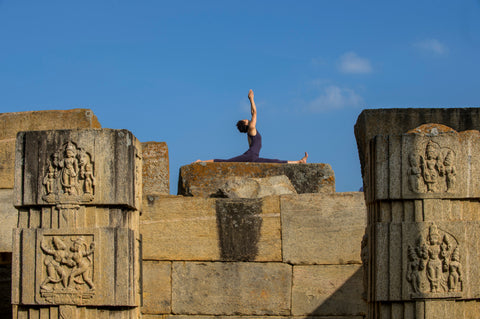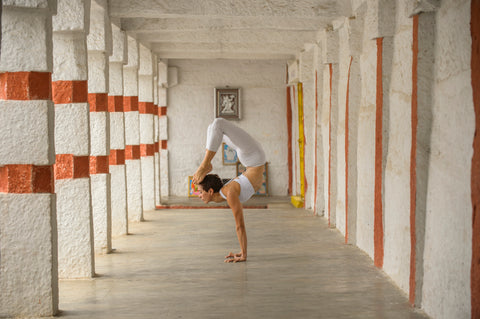“Ashtanga Yoga is the washing machine for the mind,” Guruji used to say. It washes the mental patterns of self-doubt and self-criticism: things that stand in the way of us becoming our best selves - Magnolia Zuniga
“Ashtanga Yoga is the washing machine for the mind,” Guruji used to say. It washes the mental patterns of self-doubt and self-criticism: things that stand in the way of us becoming our best selves. Deeply grounded in history and myth, it is capable of transforming the mind and body on all levels through dedicated study and practice.
The first, or “Primary” Series focuses on detoxifying and cleansing the physical body. [1] In Sanskrit, it’ s called Yoga Chikitsa, which means “yoga therapy.” For men and women, the Primary Series builds strength and endurance: lengthening the hamstrings, opening the hips, and beginning to open the spine. Its many twists help balance digestion, further removing toxins from the body. I learned the complete Primary Series within a few months. I practiced it mostly on my own for about seven years before meeting Guruji and Sharath. A few teachers I practiced with periodically were anxious to move me forward, but I wasn’ t comfortable with that. I wanted to learn directly from Pattabhi Jois. These years helped me avoid becoming entangled in a desirous relationship with postures. While I’ve never been accused of being a particularly patient woman, I found a way to practice asanas with more intelligence and clarity. Essentially this time allowed me to turn practice into a sadhana.
In the Second, or “Intermediate” Series, the student begins to go deeper. This series specifically cleanses the subtle energetic channels needed for spiritual awakening (referred to as Nadi Shodhana, or“nerve cleansing”). Yet even after practicing Second Series for eight years, I was hardly prepared for the changes the next series would set in motion.
"Asanas are like medicine in more ways than we realize. They should be prescribed slowly and cautiously, as they have the potential to alter our characters in ways we may not anticipate" - Magnolia Zuniga
I began to learn Third Series, Sthira Bhaga (divine steadiness) in 2012. Over the course of two and a half years, Sharath guided me through a few chunks at a time. While changes came slowly and steadily, this practice amounted to a huge physical and emotional transformation.
Prior to studying Third Series, I was quite thin and waifish. I was outgoing and fun, yet flaky and irresponsible. Third Series made me more introverted. I also began to set clearer boundaries with my friends, my family, and myself. This didn’t go unnoticed. I became much more comfortable with saying no and quite often. This challenged many of my friendships, some of which dissolved completely. While there are aspects of my previous self I miss, I enjoy the strength and calm that this practice has provided. And while I attribute some of these changes with the natural aging process, they became especially swift and strong once I began to work with Third Series directly. I have come to understand that the practice of sthira bhaga asks us to tap into the spiritual part of effort; that is, a more devotional and non-material way of moving.
“What will people learn from practicing advanced asanas?” one of my teachers once asked Guruji. “I don’t know,” he said. “Everyone learns what they need to learn. - Magnolia Zuniga
The slow and progressive way in which I was taught by Guruji and Sharath instilled in me a sense of respect for the process. It allowed me to integrate the effects of the postures into my life and community. Although Sharath is sometimes criticized for teaching the postures slowly (seemingly more slowly than Guruji did), I deeply respect his approach. Sharath grew up alongside the western students. His understanding of western culture has allowed him to refine his teaching prescriptions in a way that seeks to temper the egoism and appetite of the western mind.
Asanas are like medicine in more ways than we realize. They should be prescribed slowly and cautiously, as they have the potential to alter our characters in ways we may not anticipate. Nor are we aware of the challenges that these changes can facilitate on a social and cultural level. We say we’ re ready for strong, independent women, but what happens to a family and community when a woman goes through these deep changes in her psyche? Thus, it’ s always best to move forward with consideration. As my teacher once said, ‘ You wouldn't open your medicine cabinet and take all the medicine at once!’
[1] Although it’s called “primary series,” this is a misnomer. Taught properly, it can take anywhere from three months to a year or more to learn the complete series
To read the full book online, Subscribe as a Member. Click the button below.
 A direct student of Sri K Pattabhi Jois and Sharath Jois, Magnolia is a Certified Ashtanga Teacher studying 4th series at the KPJAYI in Mysore, India. Magnolia was introduced to Ashtanga Yoga in 1997-98 by teachers Noah Williams and Kimberly ‘Kiki’ Flynn in Los Angeles, CA. In 2007 she received Sri K Pattabhi Jois’s blessing to teach Ashtanga Yoga and went on to teach in Hong Kong, Japan, France. In 2015 she received Certification from Sharath Jois and as of March 27th 2015 there were only 47 Certified teachers in the world and only 17 of those are women. Magnolia teaches is currently based in San Francisco where she teaches at Mysore SF. You can find more information about Magnolia by visiting Mysore SF here. Small Photo: Sandy Lee.
A direct student of Sri K Pattabhi Jois and Sharath Jois, Magnolia is a Certified Ashtanga Teacher studying 4th series at the KPJAYI in Mysore, India. Magnolia was introduced to Ashtanga Yoga in 1997-98 by teachers Noah Williams and Kimberly ‘Kiki’ Flynn in Los Angeles, CA. In 2007 she received Sri K Pattabhi Jois’s blessing to teach Ashtanga Yoga and went on to teach in Hong Kong, Japan, France. In 2015 she received Certification from Sharath Jois and as of March 27th 2015 there were only 47 Certified teachers in the world and only 17 of those are women. Magnolia teaches is currently based in San Francisco where she teaches at Mysore SF. You can find more information about Magnolia by visiting Mysore SF here. Small Photo: Sandy Lee.




